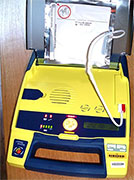- Skip Storing This Everyday Product in the Fridge Door
- Green Tea + B3 Pairing May Boost Brain Health
- Navigating Your Midlife Crisis: Embracing New Possibilities
- City Raccoons Showing Signs of Domestication
- Mapping the Exposome: Science Broadens Focus to Environmental Disease Triggers
- One Week Less on Social Media Linked to Better Mental Health
- Your Brain Changes in Stages as You Age, Study Finds
- Some Suicide Victims Show No Typical Warning Signs, Study Finds
- ByHeart Formula Faces Lawsuits After Babies Sickened With Botulism
- Switch to Vegan Diet Could Cut Your Greenhouse Gas Emissions in Half
Could You Work the Device That Restarts Hearts?


Potentially life-saving devices called automated external defibrillators are common in public places across the United States and can help rescue people suffering a sudden cardiac arrest, government health officials say.
Sudden cardiac arrest — a leading cause of death in the nation — results from a malfunction in the heart’s electrical system. Automated external defibrillators deliver an electrical shock to restore the heart’s normal rhythm. The devices are found in many shopping malls, grocery stores, airports, schools and offices.
Someone who suddenly collapses and is unresponsive and not breathing normally may have suffered sudden cardiac arrest. Bystanders need to call 911, start CPR and then look for an automated external defibrillator, says the U.S. Food and Drug Administration.
“Defibrillation is a time-sensitive issue,” Dr. Oscar Tovar-Calderon, a medical officer at FDA, said in an agency news release.
For every minute that a person in sudden cardiac arrest has an abnormal heart rhythm, the chances of survival fall by 7 percent to 10 percent, he said. If the automated external defibrillator fails to deliver an electric shock, bystanders should continue CPR until an emergency responder arrives.
Automated external defibrillators are not difficult to use and provide voice prompts to guide users, but the FDA highly recommends that people get trained in their use. Training is frequently offered along with CPR instruction by groups such as the American Red Cross, the American Heart Association and private companies.
People who have a heart condition and are most at risk for sudden cardiac arrest may want to talk to their doctor about having an automated external defibrillator at home, Tovar-Calderon said.
Each year, about 383,000 Americans with sudden cardiac arrest are treated by emergency medical responders. Less than 12 percent of those patients survive.
More information
The U.S. National Heart, Lung, and Blood Institute has more about automated external defibrillators.
Source: HealthDay
Copyright © 2025 HealthDay. All rights reserved.










